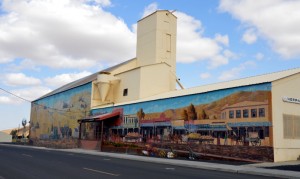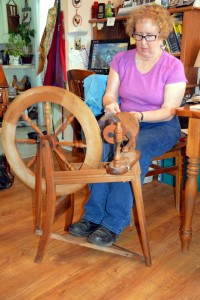by Debbie Fant
 One of the most wonderful—and humbling—things about being a public folklorist is the opportunity to explore and document other peoples’ lives. From September 2014 through September 2015, I was lucky enough to do folklore fieldwork for the Oregon Folklife Network in Morrow and Umatilla counties, where I met and interviewed amazing people—people who were generous with their time and with their stories. I encountered keepers of tradition who didn’t think what they did was anything special. So it was an honor to be able to share those stories with a wider audience in Heppner and later in Pendleton. But sharing with a wider audience—through the internet, through photos, through exhibits—is different from bringing the stories back to the people who originally told them.
One of the most wonderful—and humbling—things about being a public folklorist is the opportunity to explore and document other peoples’ lives. From September 2014 through September 2015, I was lucky enough to do folklore fieldwork for the Oregon Folklife Network in Morrow and Umatilla counties, where I met and interviewed amazing people—people who were generous with their time and with their stories. I encountered keepers of tradition who didn’t think what they did was anything special. So it was an honor to be able to share those stories with a wider audience in Heppner and later in Pendleton. But sharing with a wider audience—through the internet, through photos, through exhibits—is different from bringing the stories back to the people who originally told them.
 In Morrow County, Kathy Street, the librarian for the Oregon Trail Library System, scheduled the talk for a Friday evening in Heppner. Because the library there is in an old Carnegie building that did not have a room large enough for a public presentation, Kathy arranged for the event to be at St. Patrick’s Senior Center.
In Morrow County, Kathy Street, the librarian for the Oregon Trail Library System, scheduled the talk for a Friday evening in Heppner. Because the library there is in an old Carnegie building that did not have a room large enough for a public presentation, Kathy arranged for the event to be at St. Patrick’s Senior Center.
A variety of people showed up, including a few I’d interviewed, like Bob and Judy Stevens from up in Hardman, and Sandra Van Liew with her husband. About 25 people arrived in total, and Library Board Member Bill Kuhn introduced me.
My presentation described all of the tradition keepers that I’d encountered during my fieldwork, including Bob, who is a fiddler, and Sandra who raises Jacob’s sheep and knits a variety of items from their wool, which she also shears, cleans, hand cards, dyes, and spins.
The presentation also included a description of a water witcher in Umatilla County. A water witcher—or dowser—is someone who has the ability to find water underground. Some witchers use a forked tree branch to point to a source, others use metal rods, while a few use a pendulum.
The new minister in town, a younger fellow originally from North Carolina, said he’d come to the presentation to learn more about the traditions of Eastern Oregon. He said he was particularly interested in water witching. “Is it real?” he asked.
 The audience responded: “Yes,” they said, “it was real.” Many agreed that it had to do with some sort of electrical or magnetic energy that a water witcher naturally had. Then they moved into a lively discussion about the different people who’d been known as water witchers in the area, how many of the audience members had called on water witchers to locate the spot where a well should be drilled, how that was the only way to find water in their grandparents’ time. Everyone in the room was smiling and nodding and chiming in with a story to tell. It was fabulous! A folklorist’s dream.
The audience responded: “Yes,” they said, “it was real.” Many agreed that it had to do with some sort of electrical or magnetic energy that a water witcher naturally had. Then they moved into a lively discussion about the different people who’d been known as water witchers in the area, how many of the audience members had called on water witchers to locate the spot where a well should be drilled, how that was the only way to find water in their grandparents’ time. Everyone in the room was smiling and nodding and chiming in with a story to tell. It was fabulous! A folklorist’s dream.
That presentation was a highlight of my fieldwork, an unexpected gift from the folks in Morrow County. The audience left slowly, talking as they went out of the building. It couldn’t have been a better evening.
